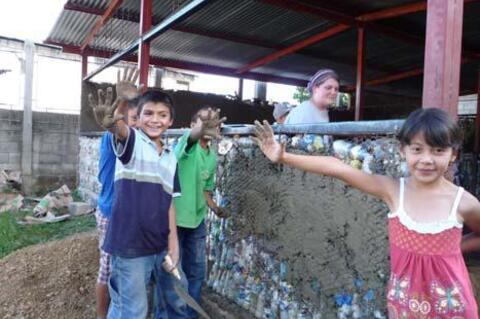Trash for Peace: Engaging Children, Youth and Community for a World without Waste

"Insufficient waste management is an issue in many parts of the world....One of the ways Laura Kutner addressed this issue in her community was by facilitating the community project of building two classrooms out of plastic bottles and trash, involving children and youth from start to finish."
Volunteer Laura Kutner addressed the problem of insufficient waste management, including trash burned outside of homes or thrown on the ground, by recycling plastic bottles as school building material in Granados, Baja Verapaz, Guatemala. As a United States (US) Peace Corps volunteer in 2008, Kutner built upon the experience and knowledge of Pura Vida Atitlan, an organisation that started building out of plastic bottles stuffed with trash, or "eco-bricks."
Kutner built agreement and participation by showing the school principal pictures of similar building projects, then co-presenting the project with the principal to teachers and parents. They then held trainings to teach the families and children on the proper techniques of bottle collection and stuffing them full of plastic or aluminium wrappers as insulation. They created visual handouts describing these methods and went to each classroom to present the information to the students, as well as to their parents at the next school meeting.
The trainers (Kutner and the teachers) used this opportunity to teach about the environment and nutrition by creating a lesson plan to teach about why they were doing the recycling. This lesson plan included the importance of not buying more soda in order to collect bottles, but, rather, to pick them up from the side of the road in order to clean up the town. They discussed how long it takes plastic bottles and other trash to decompose, and why burning trash is toxic and bad for health and the environment. In order to make these "trash" lessons fun, they would sometimes have "stuffing parties," including: singing songs; telling jokes; and putting on a trash fashion show.
Education, Environment
Once the construction began, the grades would rotate to put bottles in the wall for two hours in the mornings. Volunteers from US-based non-governmental organisation helped cement the walls.
"When evaluating this project after its completion, the teachers in the community as well as the mayor voiced that they felt that due to this project, Granados now has a greater sense of pride, an increased awareness of the ill-effects of trash and plastic specifically, and more ganas or desire to develop a long-term waste management system. In addition, this method of construction has spread all over the country." Subsequently, Kutner returned to the US and continued to make visible the need for recycling, for example, by making recycling barrels for a coffee shop out of its plastic cups. She and the Guatemalan principal from Granados demonstrated the building technique at the Smithsonian Folk Life Festival in Washington, DC, US.
This project also inspired Kutner to found the nonprofit organisation Trash for Peace (a 501c3 located in Portland, Oregon). There are many free resources on the Trash for Peace website for teachers interested in environmental education techniques.
Peace Corps, Pura Vida Atitlan, Hug It Forward
"Trash for Peace: Engaging Children, Youth and Community for a World without Waste" from Children, Youth and Environments, 22(1): 294-303, accessed August 16 2012; and emails from Laura Kutner to The Communication Initiative on June 28 2013 and October 17 2014. [Editor's note: This article is available to those who subscribe. Those wishing to request a specific article and residing in a low-income country, may make a request by email.]
- Log in to post comments
